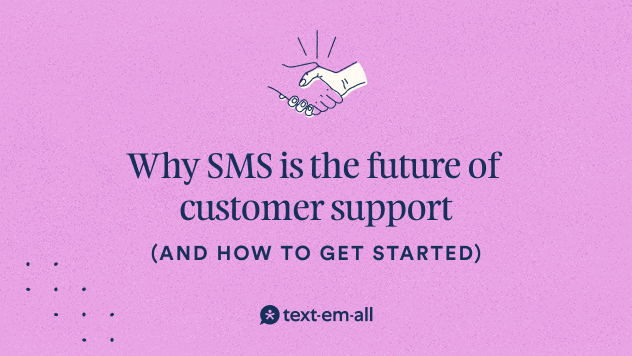6 min read
Why SMS is the future of customer support and how to get started
Ron Kinkade
:
Aug 25, 2025

Your phone rings. It's a customer with a "quick question" about their account. Twenty-three minutes later, you're still on the call, having walked through three different systems, put them on hold twice, and transferred them once. Meanwhile, twelve other customers are waiting in your queue.
Sound familiar?
Here's the plot twist: that same customer would rather text you. In fact, 31% of consumers now prefer texting over phone calls and email when they need support. They're not asking for fancy chatbots or revolutionary technology—they just want to send a quick text and get an answer without derailing their entire afternoon.
The shift isn't coming. It's already here. And the businesses figuring this out first are leaving their competition in the dust.
The numbers that should make every business owner pay attention
Let's talk about what's actually happening in your customers' pockets right now.
SMS messages get opened 98% of the time. When's the last time your marketing email hit those numbers? Never, that's when. Email open rates hover around 20-25% on a good day, and that's assuming they don't land in spam folders.
But here's where it gets really interesting: 90% of text messages get read within three minutes. Not three hours. Not three days. Three minutes. Your customers are literally carrying around a direct line to your business, and most companies are completely ignoring it.
The cost difference alone should grab your attention. The average phone support call runs about $16 per interaction, while SMS conversations typically cost $1-5. That's not just a minor improvement—it's the kind of cost reduction that shows up on your quarterly reports.
Why texting transforms customer support (beyond just being trendy)
The raw numbers tell part of the story, but the real transformation happens in how SMS changes the entire support experience. Let's break down the three biggest ways texting revolutionizes customer service operations.
Your support team can actually multitask
Remember when "multitasking" meant having three browser tabs open? With SMS support, one agent can genuinely handle multiple conversations simultaneously without anyone feeling rushed or ignored.
Phone calls demand exclusive attention. You can't exactly put someone on hold every thirty seconds to answer another caller. But text conversations flow differently. Your agent can respond to Sarah's billing question, help Marcus track his order, and troubleshoot Jennifer's login issue—all within the same hour, without anyone waiting on hold.
Many businesses see their phone call volume drop significantly after implementing text support. Those calls don't disappear—they shift to a channel that's cheaper, faster, and more convenient for everyone involved.
Speed beats perfection every single time
Here's something that might surprise you: 33% of customers would recommend a brand that gives fast responses over one that gives slow but perfect responses. We've been so focused on getting everything exactly right that we forgot customers just want acknowledgment that their problem matters.
Text messaging hits that sweet spot. You can acknowledge someone's issue immediately ("Got your message about the delivery! Looking into it now and will have an update within the hour") and then follow up with details. That immediate response completely changes how customers feel about your service.
The accessibility factor nobody talks about
Nearly everyone owns a cell phone, but not everyone has reliable internet for chat widgets or the availability for phone calls during business hours. SMS works on the most basic phones, doesn't require apps or accounts, and lets people reach out whenever it's convenient for them.
Your customer can text you from the grocery store line, between meetings, or while their kids are napping. They don't need to block out time or find a quiet space. This convenience removes the biggest barrier to actually contacting support: the hassle of doing it.
What other businesses are actually doing with SMS support
The adoption patterns tell an interesting story. Real estate agents lead with 73% using SMS for customer communication. These are people who understand that being available when clients need them directly impacts their bottom line.
Retail businesses are catching on fast, with many increasing their SMS budgets specifically for customer service applications. But here's the opportunity: only 25% of marketers currently use SMS for customer service. That means three out of four businesses are still making their customers pick up the phone or write emails for simple questions.
The purpose shift is equally telling. Businesses are moving beyond promotional texts to actual support interactions, with 39% now prioritizing customer service as their main SMS use case.
Your step-by-step implementation roadmap
Ready to get started? Here's the practical roadmap that won't overwhelm your team or break your existing processes. We'll walk through each phase so you can implement SMS support without turning your current operations upside down.
Choose your platform without getting overwhelmed
Start with the basics: you need two-way messaging, conversation management, and integration with whatever help desk system you're already using. Don't overcomplicate this.
Essential features include:
- Two-way messaging (obviously)
- Conversation assignment so multiple people aren't responding to the same customer
- Auto-responses for common questions and after-hours inquiries
- Message templates to help your team respond consistently
- Basic analytics to track what's working
Text-Em-All's business texting platform includes all these features without the complexity. The fancy AI features can wait. Get the foundation right first.
Set up workflows that actually make sense
Create categories for incoming messages based on urgency:
- Emergency issues that need immediate escalation (security problems, service outages)
- Urgent requests requiring same-day resolution (billing issues, broken features)
- General inquiries that can wait 24 hours (product questions, account updates)
- Simple questions perfect for automated responses (hours, locations, basic FAQs)
Your ticketing system should automatically sort these so urgent issues don't get buried behind routine questions about store hours.
Train your team on SMS etiquette (it's different than you think)
SMS communication isn't just shortened email. It requires a completely different approach:
Keep messages concise but complete. "Your order #12345 shipped today via FedEx. Tracking: [link]. Expected delivery Thursday by 8pm. Questions?" tells them everything without unnecessary words.
Use conversational tone while staying professional. "Hi Marcus! Checked your account and see the issue. Your next billing date got moved to the 15th after that payment change. All set now! Let me know if anything looks weird."
Know when to escalate. Complex technical issues, sensitive billing disputes, or emotionally charged complaints might need a phone call. Don't force everything into text format.
Implement automation strategically
Smart automation handles routine inquiries while preserving the human touch for complex issues. Use automated responses for:
- Initial acknowledgments ("Thanks for reaching out! We'll respond within 2 hours during business hours")
- Frequently asked questions with standard answers
- Order status updates and tracking information
- Appointment confirmations and reminders
Text-Em-All's autoresponders make this easy to set up. Set clear triggers for transferring automated conversations to human agents. If someone responds with "that doesn't help" or asks follow-up questions, route them to a person immediately.
Promote your SMS support channel effectively
Your customers can't use a service they don't know exists. Integrate your SMS support number across every touchpoint:
- Website contact pages and help sections
- Email signatures and automated responses
- Social media profiles
- Phone system hold messages
- Product packaging and receipts
- Post-purchase follow-up communications
Make it obvious and easy to find.
Best practices that actually work in the real world
Once your SMS support system is running, these practices will help you deliver exceptional experiences while keeping your team efficient. Think of these as the difference between just having SMS and actually excelling at it.
Get consent right (and manage expectations clearly)
Always get explicit opt-in for SMS communications. This isn't just legal compliance—it builds trust. Clearly communicate:
- Response times ("We respond within 2 hours during business hours, Monday-Friday")
- Operating hours for live support
- What types of issues work best via text
- How to escalate truly urgent problems
Text-Em-All's compliance features help you stay compliant while building trust with customers.
Keep conversations connected
Nothing frustrates customers more than repeating their entire problem because your systems don't talk to each other. Integrate SMS into your existing help desk platform so anyone on your team can see the full conversation history.
Follow up proactively (but don't be annoying)
A simple "Did that resolve your billing question?" text a few days later shows you care about outcomes, not just closing tickets. But don't overdo it. One follow-up is caring. Three follow-ups is harassment.
Measuring what matters
Track metrics that actually impact your business:
- Average response time (aim for under 2 hours during business hours)
- Resolution rate (percentage of issues solved via SMS vs. escalated)
- Cost per interaction (compare to phone and email support costs)
- Customer satisfaction scores (post-interaction surveys)
- Volume trends (are more customers choosing SMS over other channels?)
Text-Em-All's analytics dashboard makes tracking these metrics straightforward. Review these monthly and adjust your processes based on what the data tells you.
The future is already happening
AI integration is getting smarter, but it's not replacing human agents—it's making them more efficient. Chatbots handle routine questions while humans focus on complex problems that actually require judgment and empathy.
Rich Communication Services (RCS) is bringing enhanced features like read receipts, multimedia messages, and interactive elements to business messaging. But don't wait for the perfect technology. Start with basic SMS and evolve as better tools become available.
71% of consumers want genuine two-way text conversations with businesses. The companies that establish SMS support now will have a massive head start as customer expectations continue evolving.
Getting started without overthinking it
Begin with a pilot program. Choose one specific type of inquiry—order status, appointment scheduling, or basic product questions. Set up your platform, train a small team, and gradually expand as you refine your processes.
The technology is mature, customer demand is proven, and the benefits are measurable. Businesses using SMS report being 683% more likely to achieve digital marketing success.
Your customers are already texting. They're just not texting you yet. While your competitors debate whether SMS support is worth the investment, you can be the business that actually answers when they reach out.
Start your free Text-Em-All trial and see how SMS support transforms your customer relationships. Start small, measure everything, and scale what works. The future of customer support isn't some distant possibility—it's sitting in your customers' pockets right now.












